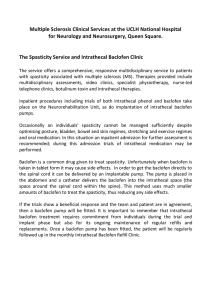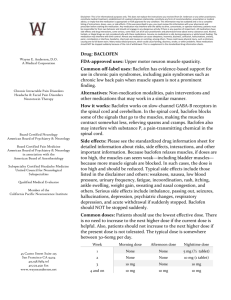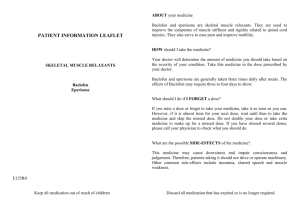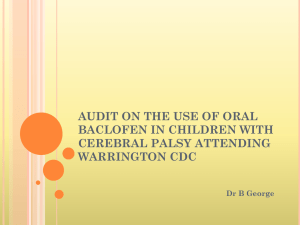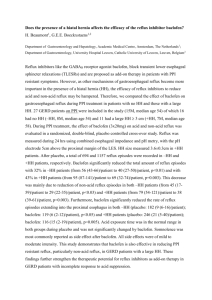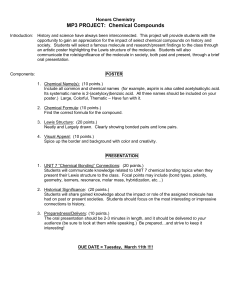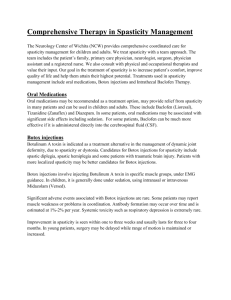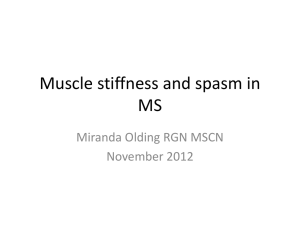03.13 VV Baclofen Toxixity by LH - Aspen Meadow Vets
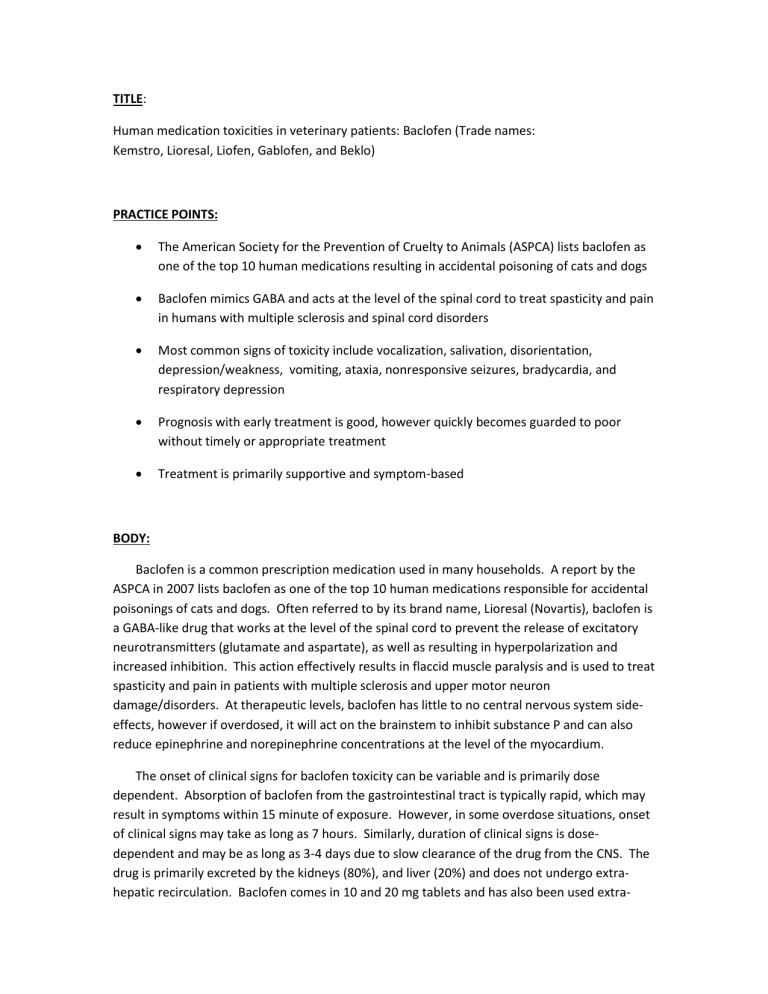
TITLE:
Human medication toxicities in veterinary patients: Baclofen (Trade names:
Kemstro, Lioresal, Liofen, Gablofen, and Beklo)
PRACTICE POINTS:
The American Society for the Prevention of Cruelty to Animals (ASPCA) lists baclofen as one of the top 10 human medications resulting in accidental poisoning of cats and dogs
Baclofen mimics GABA and acts at the level of the spinal cord to treat spasticity and pain in humans with multiple sclerosis and spinal cord disorders
Most common signs of toxicity include vocalization, salivation, disorientation, depression/weakness, vomiting, ataxia, nonresponsive seizures, bradycardia, and respiratory depression
Prognosis with early treatment is good, however quickly becomes guarded to poor without timely or appropriate treatment
Treatment is primarily supportive and symptom-based
BODY:
Baclofen is a common prescription medication used in many households. A report by the
ASPCA in 2007 lists baclofen as one of the top 10 human medications responsible for accidental poisonings of cats and dogs. Often referred to by its brand name, Lioresal (Novartis), baclofen is a GABA-like drug that works at the level of the spinal cord to prevent the release of excitatory neurotransmitters (glutamate and aspartate), as well as resulting in hyperpolarization and increased inhibition. This action effectively results in flaccid muscle paralysis and is used to treat spasticity and pain in patients with multiple sclerosis and upper motor neuron damage/disorders. At therapeutic levels, baclofen has little to no central nervous system sideeffects, however if overdosed, it will act on the brainstem to inhibit substance P and can also reduce epinephrine and norepinephrine concentrations at the level of the myocardium.
The onset of clinical signs for baclofen toxicity can be variable and is primarily dose dependent. Absorption of baclofen from the gastrointestinal tract is typically rapid, which may result in symptoms within 15 minute of exposure. However, in some overdose situations, onset of clinical signs may take as long as 7 hours. Similarly, duration of clinical signs is dosedependent and may be as long as 3-4 days due to slow clearance of the drug from the CNS. The drug is primarily excreted by the kidneys (80%), and liver (20%) and does not undergo extrahepatic recirculation. Baclofen comes in 10 and 20 mg tablets and has also been used extra-
label to treat urine retention in canine patients at 1-2 mg/kg orally TID. Even so, doses as low as
1.3 mg/kg have been reported to result in vomiting, depression, and vocalization in at least one patient. Serious clinical side-effects and even death have been reported at 8-16 mg/kg.
Treatment and monitoring for baclofen toxicity are fairly straight-forward. There are, however, some important considerations. Baseline chemistry and electrolytes measurements should be obtained in order to evaluate for possible hypoglycemia and hypokalemia. Elevated
CK, AST, and lactate have also been reported in people with baclofen toxicity. Other diagnostic modalities such as arterial blood gas, pulse oximetry, and thoracic radiographs should be considered in patients exhibiting respiratory depression and/or possible aspiration pneumonia – common sequelae in severely affected patients. Some laboratories can measure serum and/or urine baclofen concentrations; however this may be of limited clinical value given that treatment cannot wait for potentially untimely results. ECG and frequent temperature monitoring are important in hospitalized patients.
Treatment is largely supportive. Decontamination and emesis are not likely to be particularly helpful given that patients are often showing symptoms by the time they arrive for veterinary care. It is not recommend that emesis be induced in symptomatic patients. Gastric lavage may be of some worth; however, in patients with significant CNS depression, anesthetic drugs may complicate or worsen the symptoms of toxicity. A single dose of activated charcoal may be valuable in patients who have good control over their airway and the ability to swallow.
There is no need to repeat activated charcoal dosing as this drug does not undergo extra-hepatic recirculation, as mentioned previously. Some resources recommend using activated charcoal with a cathartic, however magnesium-based cathartics such as Epsom salts may precipitate neurologic symptoms. Additionally, cathartics can cause electrolyte and/or fluid shifts that may overall increase the risk of deleterious effects over that of their potential benefit.
As is the case with most toxicities, fluid therapy is the mainstay of treatment. IV fluids may increase baclofen excretion through the kidneys, as well as protect vital organs from damage that can result as a side-effect of the toxin. Diazepam (0.25-0.5 mg/kg intermittent bolus or 0.5-
1 mg/kg/hr CRI) is the preferred treatment for baclofen-induced seizures. Cyproheptadine (1.1 mg/kg PO or rectally in dogs, 2-4 mg total dose in cats) is recommended to treat vocalization and and/or disorientation. Acepromazine (0.05-0.2 mg/kg) is useful for treatment of significant agitation that may occur as the drug begins to withdrawal from the patient’s system. Atropine
(0.02-0.04 mg/kg PRN) will correct baclofen-induced bradycardia. As baclofen is a fat-soluble drug, there is some evidence that intravenous fat emulsion therapy (1.5 ml/kg IV bolus followed by 0.25 ml/kg/min over 30-60 min of 20% emulsion) may also be clinically useful and should be considered in severe or refractory patients. Although based on human research, the website lipidrescue.org offers interesting information and background to this relatively new and experimental treatment. Hemodialysis and ventilatory support are gold-standard treatments for severely affected/comatose patients when not financially prohibitive.
Baclofen toxicity may not be the most common toxicity seen in the veterinary hospital; however it is not an uncommon human medication and should be treated seriously and aggressively if suspected. There are serious and severe possible side-effects of toxicity in veterinary patients, including respiratory depression and aspiration pneumonia. With aggressive and appropriate veterinary care, patient prognosis is good, however may be guarded if not recognized and treated appropriately.
REFERENCES:
Hecht DV, Allenspah K. PResumtive baclofen intoxication in a dog. J Vet Emerg Crit Care
1998; 8:49-54.
Scott NE, Francey T, Jandrey K. Baclofen intoxication in a dog successfully treated with hemodialysis and hemoperfusion coupled with intensive supportive care. J Vet Emerg Crit Care
2007; 17:191-196.
Torre DM, Labato MA, Rossi T, et al. Treatment of a dog with severe baclofen intoxication using ehmodialysis andmechanical ventilation. J Vet Emerg Crit Care 2008; 18:312-318.
Wismer T. Baclofen overdose in dogs. Vet Med 2004; 99:406-408.
Lane I. Urinary obstruction and functional urine retention. Textbook of Veterinary Internal
Medicine: Disease of the Dog and Cat (SJ Ettinger; EC Feldman, eds). WB Saunders, Philadelphia,
PA, 2000;pp 93-96.
